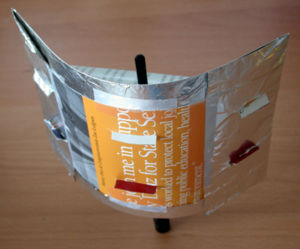How To Boost a Router Signal
Step 1 Check for interference
- Replace devices in your home that can interfere with network traffic on the 2.4GHz frequency range. These devices include many cordless phones, microwave ovens, and the like.
- Check your signal strength with these devices on and off to determine if they are the cause of your signal problems.
- Buy a wireless network analyzer to track down the source of interference.
Step 2 Change your signal channel
- Routers can broadcast on a series of channels, between one and eleven. Change to a channel that will allow your router a clear signal between other wireless networks.
- Use a software utility to analyze which networks are using which channel.
- Configure your system for an unused channel.
Step 3 Reposition your Router
- Raise up as far as possible to increase the effective broadcast range.
- Place near the center of your house or apartment for wider coverage.
- Move closer to the receivers, if possible.
- Move away from any metal including metal shelving, filing cabinets and similar common objects.
- Move away from cordless phones and microwaves, which operate on the same 2.4-Ghz frequency.
- Move away as far as possible from your neighbor's Wi-Fi router (which, of course, you should also make sure you're using a different channel)
Step 4 Raise your transmit power
- Check your router's documentation and configuration utility for the ability to change the Xmit power of your router: the amount of power it uses to transmit the signal. generally you can boost this number by up to 50mW, however you do risk overheating or damaging your router.
Step 5 Replace the Antenna
- Unscrew and replace the broadcast antenna on your router with a model that delivers more power. Not all routers allow for new antenna to be attached, but many do.
Step 6 Install a Repeater
- Purchase a repeater. A repeater is a piece of hardware that acts like a wireless network expander. The repeater takes the signal from your router and boosts it to increase the range.
- Wireless repeaters are increasingly common and affordable and will probably be available in your local computer store, or on the Internet.
Step 7 Install a Wireless Amplifier
- Purchase and attach a wireless amplifier, also known as a booster, directly to your router. A booster can be more affordable than a repeater as they only increase the strength of your existing signal, rather than the strength and range.
- Use a bi-directional amplifier to increase both your inward and outbound speeds.
Step 8
 Make a Reflector with Tinfoil.
Make a Reflector with Tinfoil.Note that a tinfoil router may boost your signal, but will also make it more directional.
- Cut a tinfoil circle with the tinfoil on the inside of a piece of paper or some cardboard large enough to wrap around the router. If you want to get fancier than this, cut a shallow parabola and put the hole for the antenna at the focal point.
- Place the tinfoil circle over the router.

- Place the antenna in the center of the circle or parabola.
Tips
- Older and traditional homes have walls made from wooden studs, while newer construction in office buildings, malls and condominiums are often constructed with metal studs in the wall. metal studs can interfere with a router signal quite badly, so consider your building type when diagnosing your signal.
Warnings
- Do not overheat your router.
- Remember: in some states this can be illegal so do your homework first.
Things You'll Need
- Router also known as an access point.
- Tinfoil.
- Paper or cardboard.
How to make a crossover ethernet cable from scratch
Learn How to make a crossover ethernet cable from scratch. For more Computer Networking How-To Videos & Articles, visit WonderHowTo.
In this video tutorial, viewers learn how to make a crossover cable from scratch. Users will need an Ethernet cable. Begin by removing one side of the connector and strip off the outside casing. Then separate the wires. Change the sequence order of the cables to: white green, green, white orange, blue, white blue, orange, white brown and brown. Make the cables straight and close together. Then cut off about half of the wires and carefully put back on the connector. Use pliers to squeeze the connector on. This video will benefit those viewers who would like to learn how to create a connector cable from a standard Ethernet cable to connect to the Internet.
How to use & enable Windows Remote Desktop
Learn How to use & enable Windows Remote Desktop. For more Computer Networking How-To Videos & Articles, visit WonderHowTo.
In this video, Nathan Galieti explains how to use Microsoft's Remote Desktop software to remotely connect to a Windows computer from another Windows or even Macintosh computer. With this software you can visually interact with the remote computer the same way you would if you were there: just click on icons, print to your localprinter, send e-mails, & copy files. Remote Desktop is a great way to connect to that home computer while you are on the road or, since you gain full control of the computers with your local mouse and keyboard, for remotely fixing a computer for someone. Want to see us make a video on how to remotely connect to a Macintosh computer?
How to access your home computer remotely with dynamic DNS
Learn How to access your home computer remotely with dynamic DNS. For more Computer Networking How-To Videos & Articles, visit WonderHowTo.
This is a great solution if you need to get something off your computer, but you are not home.
Want access to your files stored at home? How about hosting a home web server? Static IPs are expensive, if you can even get one. We set up Dynamic DNS instead!
'Back in the day' if you wanted to run a web server, email server, or FTP server from home you needed a static IP... and they often added quite a bit to the monthly bill from your ISP.
Dynamic DNS, however, lets you use a DHCP assigned address -the kind you probably have at home- just like a static IP address. That means if you have a broadband connection and sign up for a free account at DynDNS you can run a website or FTP server straight from your home.
We show you how to set it up on this episode of Systm, along with a quick and easy way to share files you and your friends can access through any browser: HFS, the HTTP File Server!
How to control your PC from anywhere
Learn How to control your PC from anywhere. For more Computer Networking How-To Videos & Articles, visit WonderHowTo.
Systm is the Do It Yourself show designed for the common geek who wants to quickly and easily learn how to dive into the latest and hottest tech projects. We will help you avoid pitfalls and get your project up and running fast.
Search Systm on WonderHowTo for more DIY episodes from this Revision3 show.
If you don't want to leave the contents of your PC at home, nor do you want to lug the computer around, check out this video for some information on how to access your machine at home from anywhere!
From Revision3:
Get to your home PC when you're on vacation, whether to download copies of the baby pixs, some fresh music, or upload a bunch of pictures you want off your camera!
Bypass network blocks at the office so you can run Twitter or browse to any website!
Fix Dad's PC... even when it's three states away!
Call us enthusiastic, but we're all about setting up remote access using remote control software on this episode of Systm!
There are a number of ways to do this... commercial tools, open source tools like VNC, and even something that Microsoft already stuffed inside some versions Windows XP, Vista and 7.
This is different from DynDNS,that allows you to find your home server no matter what IP address your ISP assigns you. Many of the services we're talking about today already have this ability built in.
There are tons of commercial applications to do this. They usually charge a monthly fee, but can save you lots of work setting things up. We talk the following applications, and tell you which ones are the best deal and why:
pcAnywhere GoToMyPC.com LogMeIn.com
We also walk you through setting up free tools, such as the Remote Desktop Connection tool that have been built into many versions of Windows since XP.
That includes the basics of port forwarding, which you'll need to set up in your router for most DIY remote connection tools.
Finally, we get our geek on and walk you thru setting up VNC, aka Virtual Network Comput
How to create a wireless network at home
Learn How to create a wireless network at home. For more Computer Networking How-To Videos & Articles, visit WonderHowTo.
Anyone can set up their own wireless network. All you need is a little know-how. You will need a computer with wireless capability, a high-speed modem, a wireless router, and a broadband internet connection. Don't get tied to the wall; a wireless connection will allow you to move the computer freely around your home and still get an internet connection. Watch this video tutorial and learn how to hook up a wireless network at home.
How to create a wireless network in your home
Learn How to create a wireless network in your home. For more Computer Networking How-To Videos & Articles, visit WonderHowTo.
The video is a simple video which explains how to create a WiFi network in your house. Doing so makes it easier to connect wireless devices and gaming consoles to the internet. He explains each step in detail. From buying the router, to which router you should buy, to how to install the router software. He also explains the process for two operating systems, the operating systems being Windows 7 and Mac OS X. The process only takes about half an hour at most.
How to share an Internet connection without WiFi in Windows
Learn How to share an Internet connection without WiFi in Windows. For more Computer Networking How-To Videos & Articles, visit WonderHowTo.
Want to share Internet connectivity between two computers without a wireless network but have an extra CAT5 ethernet cable? You're in luck. This home networking how-to will show you what to do to get your machines talking not only to one another but the web at large.
Internet Connection Sharing is a way to share your Internet connection for other computers. It requires two network cards on your computer. It also requires a crossover cable or a switch/hub between your network cards. You can use this if you have to pay for an internet connection. With ICS two or more people can connect while only paying for one. You can also use this to make a machine as a gateway for your office. However, complications arise if you are running a Windows Active Directory domain or already have a DHCP server. This feature is available on Microsoft Windows 2000, XP, Vista, 7, Server 2000, 2003, 2008

No comments:
Post a Comment